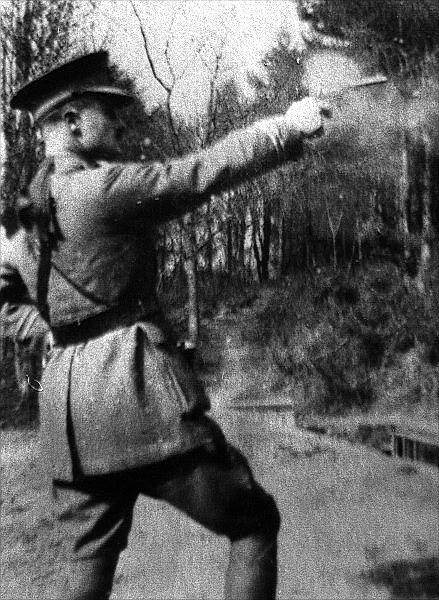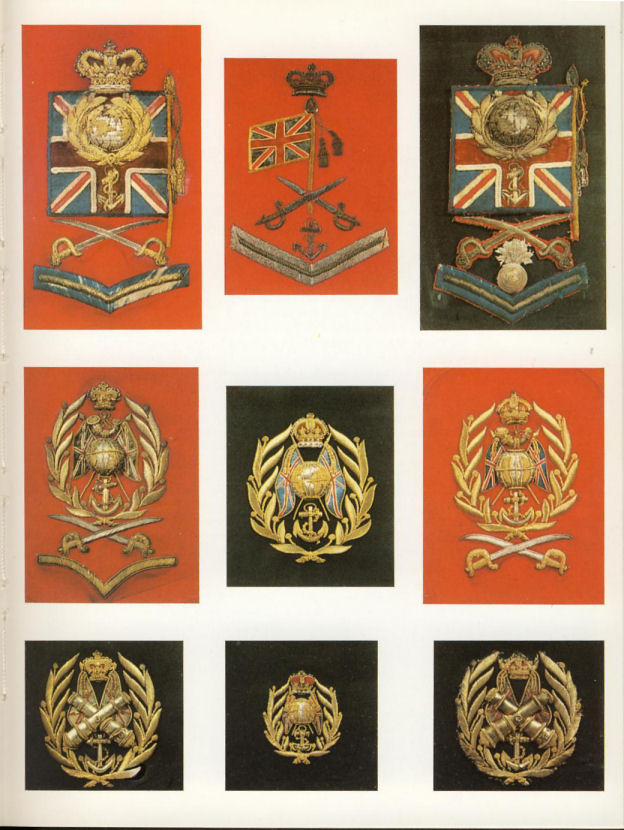
david grumpy
-
Posts
46 -
Joined
-
Last visited
Content Type
Profiles
Forums
Blogs
Gallery
Events
Store
Posts posted by david grumpy
-
-
surely its value is what you paid for it?
0 -
Nice, thank you. Please have a look at Good Conduct Badge qualifying periods: in fact
2 ½ yrs, 5, 10, 15 etc etc from 1961. There was also a 4-bar issued.
Also, your No 2 Foot Guards CQMS is in fact an RQMS, Ft Gds corporal is a lance-corporal, and you are missing the small Royal Arms for a WO I not being an RSM [eg Superintending Clerk
0 -
On 7/6/2016 at 22:06, madmart2908 said:
can anyone please tell me if british WW2 ARMY OFFICERS ever wore trade badges on their uniforms ? ( - example sniper, bomb disposal, driver etc ? ) and did a officer change cap badges on their uniform to general service officers cap badge & dog collar badges whilst awaiting re-posting of a command from one regiment unit to another or was the officers general service cap badge just for NEWLY commissioned officers out of officer training school who was awaiting assignment to a regiment ?
Most certainly some badges worn by qualified officers:
SAS, para operational, para qualified, commando qualified, bomb disposal, pilot, glider pilot,
In the Great War we can add trench mortar, bombing officer, scout officer also
The above list is off the top of my head and is not complete.
0 -
and the same goes for eating all the pies, by the look of it.
0 -
Hi David - I think we just used the term "trumpeters" as a general description as we still haven't discovered exactly what their role is. I noted the buglers cords, but they aren't wearing drummers uniforms either, which one would have expected, as all of the battalion bands regular and TF/TA comply with dress regs for bands. Looking at the trumpets(which appear to have keys too) and trumpet banners which are adorned by the City arms of Newcastle-on-Tyne, they appear to be acting in a civic role on behalf of the City, so they may well be unofficially titled "Lord Mayors trumpeters" or "Civic trumpeters". They may have also shared the role with other units which were based around the city i.e. Northumberland Hussars. As it stands though it's the first time I've seen them using this type of instrument, but still don't why or what the occassion was.
The more I look, the stranger it looks! The tunics [i suppose they are the 7 button tunic, not a trimmed 7 button frock?] are difficult to date, no facings visible. I still think the cords mean Drummer' but you may well be right about a non-regimental role on the day.
I dare not argue with you about NF !
0 -
Trumpeters of the Northumberland Fusiliers, a TF unit?
Note one man has his trumpet banner affixed the wrong way round.
Cue Graham.......
Ahem! Ahem! Whatwhatwhat!
Why ROYAL?
And please, there are/were no trumpeters in the infantry ....... I accept that they are puffing a form of trumpet, but they are either Drummers [which I suspect is the case, see the green [non-Royal] dress cords], or Bandsmen.
0 -
Book arrived, lots of nice photos. but he just says that the serge jacket was cut to the 1897 KD pattern ........... I am far from convinced.
0 -
Whoever it was didn't give a monkeys about appearance, so he was never an RSM or an Adjt!
I tried writing this man's life story from the ribbons ...... joined/went to Front TF after 31 Dec 1915, DCM in ranks, MiD, commissioned perhaps [which war?], MC and bar, [but could be as a WO], various TF awards, civil awards, GSM somewhere, served WWII all over the place Africa, Italy, Europe, you name it .....
Dread thought, they might not be kosher.
0 -
Graham, thank you for those two contributions: I have ordered Haythornthwaites "Boer War Brit Uniforms" [not correct title] to see if the SA issue is described and illustrated and a bit of background given.
0 -
The Siege of Mafeking was the most famous British action in the Second Boer War. It took place at the town of Mafeking (now Mafikeng) in South Africa over a period of 217 days, from October 1899 to May 1900, and turned Robert Baden-Powell, who went on to found the Scouting Movement, into a national hero. The Relief of Mafeking (the lifting of the siege) was a decisive victory for the British and a crushing defeat for the Boers.[1]
0 -
OK!
The badge was invented in c.1904 which is 20th Century not 19th.
'Scouting', both for the army and for boys, became all the rage in the ten years that followed the end of the SA [boer] War, ie 1902 onwards.
I do not have a firm date for the India Pattern badge, but the British Fleur-de-Lys large size was sealed and introduced 1905, the small size 1907, whereas the India version appears for the first time in Indian Clothing Regs 1909 although photo evidence says a few years earlier.
0 -
No, not at all, it would ruin the fun of detective work. I like to make old photos talk to me!
0 -
Two things to note:
the wound badge was for each OCCASION wounded, not each wound, and gassing counted, as did enemy barbed wire.
There is no truth in the oft-heard cobblers that the double Russia braid badge was for officers: it was the only official issue, widely flouted by using the private-purchase tailors gilding metal versions.
Naturally, the latter have survived rather better.
0 -
I arrive at this thread rather late. The illustrations are excellent, and the extracts from Regulations illuminating, but do please be careful to read Graham's captions: a fair number are quotes from TF, VF, Militia or SR regulations and therefore not applicable to regular forces.
There is, however, a fair bit of sentimental codswallop written, spoken, and thought about boys in the army.
'The past is a different country' we are told. Indeed, as recently as when Frank Richards DCM MM 2ndRWF left school, it was at age 12 years to go straight to work. My grandfather who fought in the Great War left school at 14. The army recruited boys at 14, with a view to training drummers, pipers, trumpeters, buglers and tailors. Many such went on to high rank, and quickly. Mobilization Regs 1914 specifically permitted COs to take drummers etc under age on Active Service. 'Drummer' was not an appointment for any ordinary soldier, and it carried extra responsibility and pay.
Regarding Isandhlwana, I once did an analysis of the ages of those listed as drummers among the dead. I had been hoping to find evidence of lots of boys on the list, but was surprised at the maturity where there was evidence of age. Unfortunately, my Zulu War material is in the attic, but I could dig out the evidence if anyone is interested.
Don't believe all you read about the aftermath of Isandhlwana either: I studied at the feet of FWD Jackson, the great expert on the primary sources, and he was dismissive of most of the lurid nonsense, especially the D Morris stuff.
But, as I said, great illustrations.
0 -
almost certainly not
0 -
never say never, regarding RWF, a very idiosyncratic regiment indeed. I would be not at all surprised if the RSM and some other senior appointments managed to sport a flash.
0 -
Lt Raffles 2RWF blasting off his six gun, flash firmly attached
 0
0 -
Field Marshal French was very anti the wearing of the flash immediately pre-1914, but it is by Royal command, and he was seen off.
0 -
there again, perhaps they could not
0 -
He was an exemplary soldier regarding conduct.
The periods [up to turn of century] were
2,6,12,18*,23*,28* years, with acceleration by two years for the * items, which he achieved.
One assumes he went to full pension at 21 years. One doubts if his last badge ever got sewn on!
0 -
another thort .... I would be surprised if the badge was 19th century.
Mafeking had not happened, Baden-Powell had not happened, Scouting [military] was not the in-thing.
More like 1904 =20th century.
0 -
Here we go, from Per Mare, Per Terram : A History of the Royal Marines, by Peter C. Smith (1974)
Left to right (I may be slightly wrong about the exact dates),
Top : RM, 1829-1856; RMLI, 1856-1869; RMA 1829-1856
Middle : RMLI, 1869-1902; RM 1922-1953; RMLI 1902-1922
Bottom : RMA, 1869-1902; RM 1953 onwards; RMA 1902-1922

Eric
Many many thanks : badges fabulous!
0 -
If a soldier earned an army pension, he received an additional 6d per day pension [Pay Warrant 1912]. There was no provision for extra for a clasp. Neither was there anything for a short-service soldier other than gratuity.
To him that hath, shall be given .............
0 -
one had to serve in the ranks for a long time to qualify for LS&GC. I have known several Sqn Ldrs with the medal, however, one a Padre.
0


Briish Army skill at arms badges & trade badges
in Great Britain: Militaria: Badges, Uniforms & Equipment
Posted
I will hold back on the other problems until I see a reply.